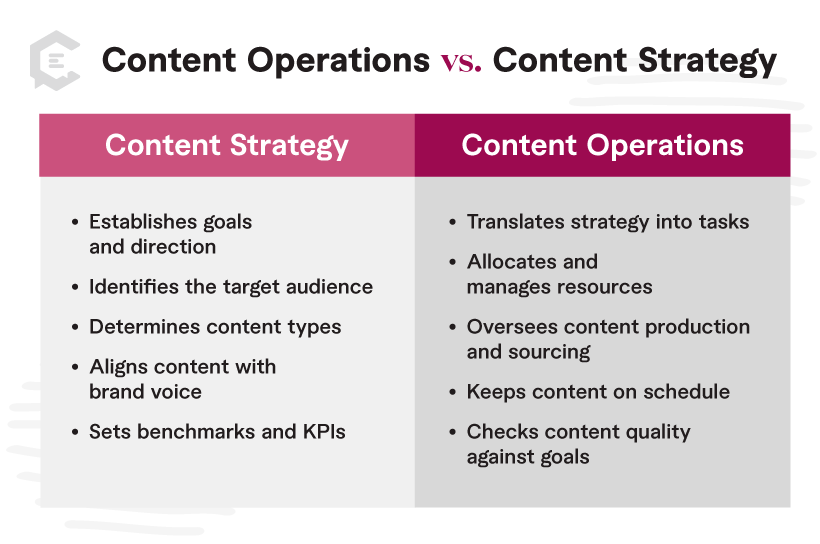Creating the most incredible plan imaginable won’t matter if you’re not delivering results.
When means it’s all about your execution. The success of that execution depends on how well your content operations support your content strategy.
Content operations and content strategy are intrinsically tied together. The more you understand their different functions, the better you can align them to work together to drive success.
In this article, we’ll explore the interplay between content operations and content strategy and why investing in your content operations is critical to your content marketing success.
A Quick Primer on the Fundamentals
Let’s lay a foundation to ensure we’re all on the same page.

What is Content Strategy?
At its core, a content strategy is your master blueprint. It outlines your content marketing efforts and how they’ll achieve your marketing and overall business objectives.
The most effective content strategies have these key components:
- Audience analysis
- Goal-setting
- Research and planning
- Content creation
- Content optimization
- Content distribution
- Analysis of success
- Refinement and adjustment
If you want to upgrade your current strategy or create one from scratch, start with our 25 Questions to Elevate your Content Strategy.
Why it’s important
Content strategy provides a clear direction and purpose for your content marketing. Without it, there’d be:
- Lack of focus: Content without strategy leads to haphazard results like irrelevant or inconsistent messaging.
- Misalignment of goals: No content strategy means no marketing goals that align with your overall business objectives.
- Audience disconnect: Content might miss the mark with the target audience and struggle to drive engagement.
If that doesn’t convince you, 80 percent of successful marketers have a documented strategy.
What are Content Operations?
Content operations are the collection of people, processes, and tools you use to execute your content strategy. It’s the behind-the-scenes engine that powers everything from content creation to management and distribution.
If content strategy is the blueprint, content operations are the infrastructure.
Operations cover four key areas:
- Financial and resource management: 54 percent of businesses plan on increasing their content marketing budget this year. Content operations involve crafting your budget, tracking expenditures, and allocating resources to ensure every dollar spent aligns with your content strategy. Also, optimizing output and efficiency by identifying the most cost-effective solutions and tools and using the right mix of internal and external resources.
- Content production workflow: The end-to-end process of creating content. Crafts well-structured and effective workflows to produce everything efficiently. That included collaboration and communication across teams and departments, adhering to timelines, and using content management systems (CMS) to streamline processes.
- Publishing and distribution strategy: How and where content is published. Selecting the right channels for distribution, scheduling content releases to maximize reach and engagement, and integrating cross-platform promotional activities to ensure a wider reach.
- Analytics and performance metrics: The most common challenge B2B marketers have while measuring content performance is integrating/correlating data across multiple platforms (84 percent). By regularly reviewing metrics and having the right systems in place, content operations can gain insights into what types of content work best, which channels are most effective, and how to refine the strategy to achieve the desired impact.
Every content marketer has some form of content operations. The real question is how well your content operations are thought out and organized.
Why it’s important
Bottom line, content operations ensure every piece of your content strategy and management works smoothly. Without a strong operations infrastructure, you get:
- Inefficiency and delays: Poor workflow management and communication can cause bottlenecks in production, wasting precious time and team resources.
- Wasted resources: In a recent CMI study, the most frequently cited non-creation challenge, by far, is a lack of resources. But sometimes, that has to do with not allocating them properly. Lack of operations can lead to overuse or underutilization of assets and personnel, impacting your ROI.
- Quality issues: Without processes in place, your content can lack quality and consistency. That can weaken your brand’s reputation and negatively affect engagement. Fifty-three percent of marketers right now are focusing on improving the quality of their content. With the right operations in place, you won’t have to. Which frees you up to focus on higher-level tasks.
- Lack of content relevance and freshness: Audience behavior and market trends always evolve. You need your operations to put a system in place to monitor those changes and keep your content up-to-date and tailored to your audience. Otherwise, you won’t be one of the companies generating 40 percent more revenue from personalization.
Content Operations and Content Strategy Side-by-Side
For the sake of clarity, let’s break them down even further. Here’s a side-by-side comparison:
Content strategy
A robust content strategy is the heart of any impactful content initiative. Here’s how it makes its mark:
- Goal orientation: It establishes clear, overarching goals and the direction of your content, ensuring every content piece has a purpose.
- Audience insights: By identifying and understanding your target audience, a content strategy ensures your content solves specific needs and challenges.
- Content diversity: It determines the types of content that will engage your audience the most effectively and be produced.
- Brand consistency: A content strategy ensures all your content aligns with your brand’s voice and message, maintaining consistency across all your distribution channels.
- Guides analytics: It sets benchmarks and Key Performance Indicators (KPIs) to measure the success of your content efforts, enabling you to track your progress and adjust strategies as needed.
Content operations
Content operations involve the nitty-gritty of turning strategic visions into reality through meticulous planning, coordination, and execution. Here’s a closer look:
- Actionable tasks: Content operations break down and organize your content strategy into manageable steps to execute.
- Resource management: It also ensures smooth execution by allocating and managing essential resources like budget, personnel, and technology.
- Content production: Another key function of content operations is overseeing the logistics of your content creation and ensuring it aligns with your overall strategy.
- Publishing schedule: It also makes sure that production meets its deadlines, publishes on time, and maintains a consistent workflow.
- Quality assurance: Monitoring the quality of content is crucial to ensuring it meets audience expectations and your content strategy goals.
Bottom Line
Ultimately, content strategy provides the roadmap, while content operations drive the content to its destination. And because they form the backbone of any successful content marketing campaign, it’s essential to make sure they work together.
The Interplay of Content Operations and Content Strategy
Establishing a strong relationship between content operations and content strategy is crucial when you’re managing content initiatives (especially if they’re large in scale). Each has its own distinct functions and roles.
Let’s explore how they work together.
Strategy guides, Operations execute
Let’s take the movie industry. Your director is the leader of a film. They’re the ones that decide on the creative vision and direction a film is going. That’s your content strategy.
Your producer is in charge of figuring out how to execute that vision. They’re in charge of all the logistics. The people, the schedule, the locations, the technology. It’s their job to support the director in making the most successful film possible. That’s your content operations.
An easier way to say it is, “Strategy guides, Operations execute.”
Why You Need to Invest in Content Operations
“A documented, enforced Content Operations framework powers a brand’s ability to deliver the best possible experiences.” – Cathy McKnight, CMI Content
We’ve talked to many marketers who’ve avoided implementing a formal content operations framework over the years. And we get it. Content operations aren’t fun or flashy. It’s grunt work. Nobody wants to organize and align everything together (except maybe us).
But at the end of the day, we all know that content marketing is about giving your customers the best possible experience with your brand. And if you want to do that, you need a formal, high-quality content operations framework.
Here’s what investing in one can do for you:
- Increased ROI: The better your content operations, the better your budget is allocated. That efficiency directly translates into higher engagement rates, more conversion, and a stronger bottom line.
- Resource optimization: Content operations ensure you use the right resources for the right tasks. It eliminates redundancies, assigns personnel where they’re most effective, and makes better use of technology for automation and analytics.
- Data-driven decisions: Operations can continually optimize your strategy and content creation by tracking and analyzing content performance. That data shows what resonates with your audience and informs how to refine your content strategy to better meet audience needs and business objectives.
- Higher employee satisfaction: No one wants chaos or confusion among their teams. Clarity in roles, responsibilities, and processes makes employees feel empowered and less frustrated. Which increases productivity and fosters a positive workplace culture. A recent employee study revealed the top two drivers of employee engagement are doing meaningful work and positive co-worker relationships.
Outsourcing and scalability
Right now, some companies are clamping down on budgets. Others are trying to scale up. Either way, executives are pressuring marketing teams to make their budget go further than ever and do as much as possible to maximize impact. It’s essential to optimize your team.
Many marketers are turning to outsourcing as a cost-effective solution, with 48 percent of companies outsourcing their content marketing.
Outsourcing allows you the flexibility to adapt your resources to changing content demands throughout the year. You can scale up for major campaigns or adjust your content production for seasonal fluctuations. The right outsourcing teams give you the agility to swiftly respond in real time while mitigating the constraints of your in-house team. And it creates a greater potential for scalability.
Scaling content production involves managing a lot of moving parts. Full-time employees are a fixed cost. With outsourcing, you can dynamically allocate your funds where needed most. You can also incorporate contractors with specialized skill sets to boost niche areas of your content creation, operations, and strategy.
If you want to dive deeper into maximizing the impact of your content marketing team without additional headcount, read our in-depth guide.
If you have a complex organizational structure
The more complex your organization structure is, the more essential your content operations are to success. Implementing a structure that aligns multiple departments, teams, and stakeholders toward a unified goal can take a lot of legwork. You need to have:
Clear communication channels
Miscommunication or siloed information can dilute the overall impact of your strategy. Clear channels foster a cohesive approach, ensuring everyone involved in content creation, management, and distribution is on the same page. Hold regular meetings with your team and across different departments (break down those silos). And use leverage collaborative platforms or project management tools like Slack or Monday to enhance communication.
A centralized content management system (CMS)
Only 31 percent of B2B marketers say their organization has the right content management technology. Implementing all-in-one operational solutions like a CMS puts all your content-related activities in one place. It can support planning, creation, distribution, and analytics. That will streamline workflows while facilitating smooth collaboration across different departments. We recommend HubSpot.
Defined roles and responsibilities
It might sound silly, but it’s easy for tasks to overlap or get overlooked, especially in a complex organization. Delineating each team member’s role and purpose ensures they know how they fit in the content lifecycle. That simple action can reduce a lot of redundancies and boost each person’s productivity and the overall productivity of your content marketing efforts.
Bonus tip: Have a dedicated content operations team or leader.
This person (or people) can be your lynchpin, bridging gaps between marketing, sales, and customer service to make sure everything aligns with broader organizational goals.
Let Your Operations Propel Your Strategy Forward
Maximizing your impact in content marketing requires mastering the relationship between content strategy and operations. You can’t have one without the other (well, you can; it just won’t be effective).
At ClearVoice, we prioritize both by combining expert strategists and creators with streamlined workflows to create a well-oiled machine that drives your success. Connect with us today to get started.









